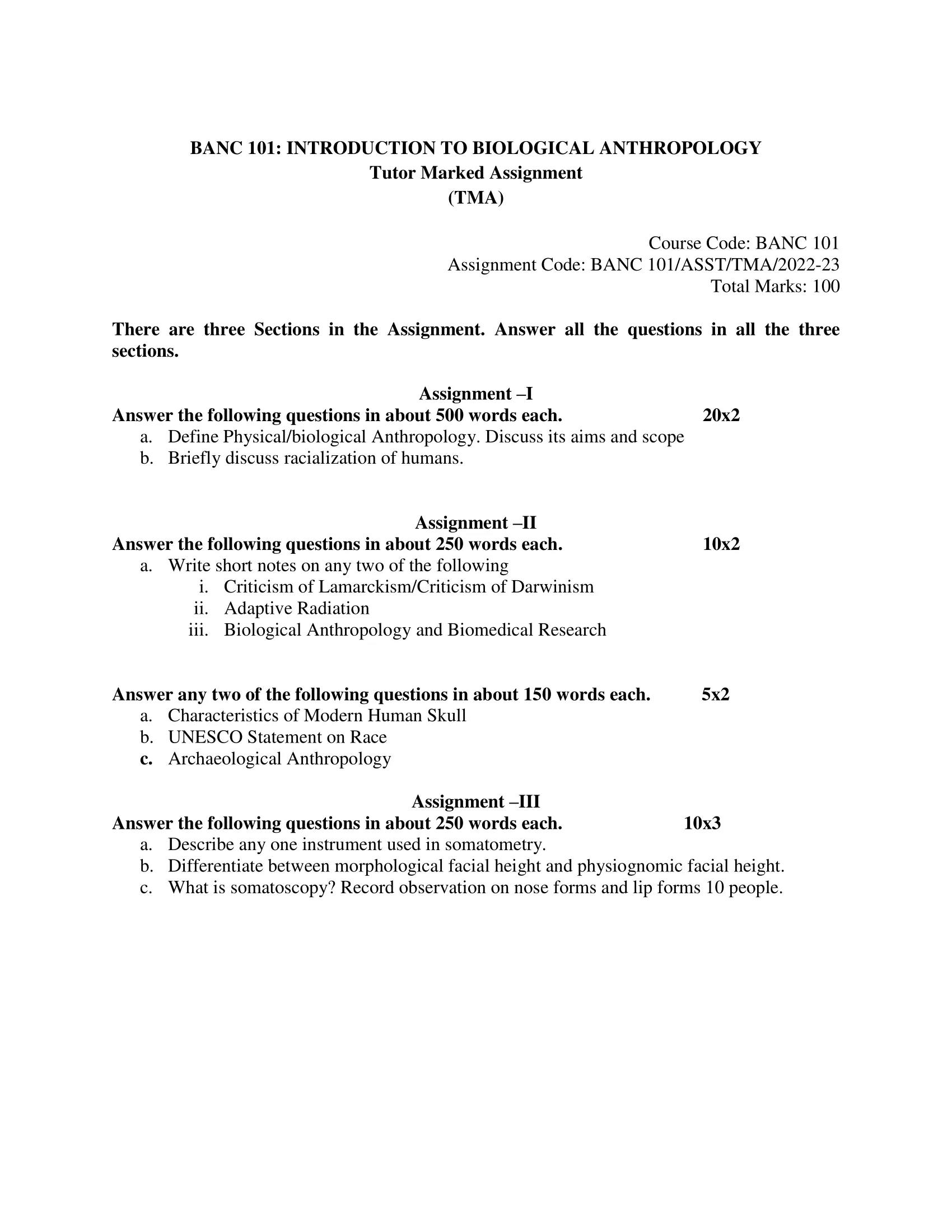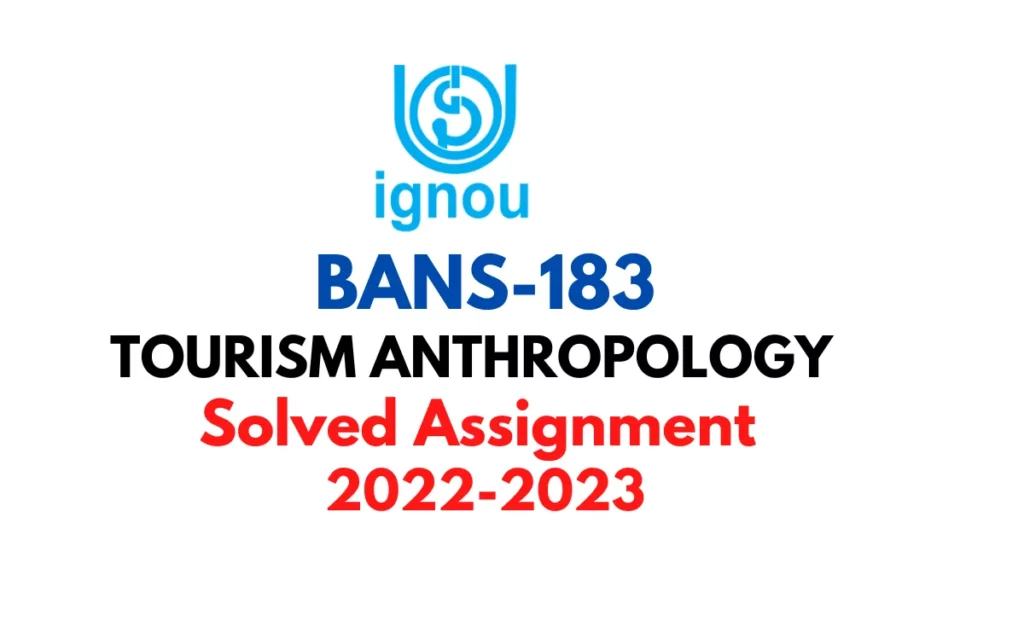Contents
- 1 Assignment –I
- 2 Answer the following questions in about 500 words each. 20×2
- 3 a. Define Physical/biological Anthropology. Discuss its aims and scope.
- 4 b. Briefly discuss racialization of humans.
- 5 Assignment –II
- 6 Answer the following questions in about 250 words each. 10×2
- 7 a. Write short notes on any two of the following:
- 8 i. Criticism of Lamarckism/Criticism of Darwinism
- 9 ii. Adaptive Radiation
- 10 iii. Biological Anthropology and Biomedical Research
- 11 Answer any two of the following questions in about 150 words each. 5×2
- 12 a. Characteristics of Modern Human Skull
- 13 b. UNESCO Statement on Race
- 14 c. Archaeological Anthropology
- 15 Assignment –III
- 16 Answer the following questions in about 250 words each. 10×3
- 17 a. Describe any one instrument used in somatometry.
- 18 b. Differentiate between morphological facial height and physiognomic facial height.
- 19 c. What is somatoscopy? Record observation on nose forms and lip forms 10 people.

| Title | BANC-101: IGNOU BAG Solved Assignment 2022-2023 |
| University | IGNOU |
| Degree | Bachelor Degree Programme |
| Course Code | BANC-101 |
| Course Name | INTRODUCTION TO BIOLOGICAL ANTHROPOLOGY |
| Programme Name | Bachelor of Arts (General) |
| Programme Code | BAG |
| Total Marks | 100 |
| Year | 2022-2023 |
| Language | English |
| Assignment Code | BANC 101/ASST/TMA/2022-23 |
| Last Date for Submission of Assignment: | For June Examination: 31st April For December Examination: 30th September |

Assignment –I
Answer the following questions in about 500 words each. 20×2
a. Define Physical/biological Anthropology. Discuss its aims and scope.
Ans: Physical/Biological Anthropology is the scientific study of human biology and behavior from an evolutionary and biocultural perspective. It aims to understand the biological and cultural processes that shape human populations, as well as the evolutionary history of the species.
The scope of Physical/Biological Anthropology is broad, incorporating diverse subfields such as human genetics, human anatomy and physiology, primatology, human evolutionary biology, human variation and adaptation, and the study of human remains.
The aims of Physical/Biological Anthropology are multi-faceted. On one hand, it seeks to understand the biological mechanisms that underlie human evolution, adaptation, and diversity. This includes the study of human morphology, physiology, and genetics to determine how and why certain traits evolved.
On the other hand, Physical/Biological Anthropology also aims to understand the cultural processes that shape human populations, including the impact of cultural practices, beliefs, and behaviors on health, disease, and well-being.
The field of Physical/Biological Anthropology also seeks to provide a holistic understanding of human biology and behavior by integrating findings from multiple disciplines, such as archaeology, sociology, and psychology. This interdisciplinary approach allows for a more comprehensive understanding of the human experience, and how biological, cultural, and environmental factors interact to shape human populations.
Another important aspect of Physical/Biological Anthropology is the application of its findings to practical problems. For example, the study of human variation and adaptation can provide insights into the development of interventions for diseases and conditions that disproportionately affect certain populations.
b. Briefly discuss racialization of humans.
Ans: Racialization refers to the social and historical process of creating, maintaining, and reinforcing racial categories and differences. It involves the attribution of traits, behaviors, and characteristics to individuals based on their perceived racial identity, and the allocation of resources and opportunities based on these perceived racial differences.
In the context of humans, racialization has been used to justify social, political, and economic inequalities, often leading to discrimination and prejudice towards certain groups. The concept of race as a biological category has been discredited by scientific research, which has shown that race is a socially constructed concept, rather than a biological one.
However, despite this, the idea of race continues to shape social perceptions and relationships. It affects how individuals are perceived and treated, influencing access to education, employment, healthcare, and other important resources.
Racialization has a long history, with roots in colonialism and slavery, and has been used to justify the exploitation and oppression of marginalized groups. The legacy of racialization continues to impact contemporary society, and is evident in ongoing disparities and inequalities based on race.
It is important to recognize and challenge the ongoing impacts of racialization, in order to promote social justice and equity for all individuals, regardless of perceived racial identity. This includes educating people on the social construction of race, and promoting critical examination of the ways in which race continues to shape social, economic, and political systems.
Assignment –II
Answer the following questions in about 250 words each. 10×2
a. Write short notes on any two of the following:
i. Criticism of Lamarckism/Criticism of Darwinism
Ans: Lamarckism, also known as the theory of inheritance of acquired characteristics, was first proposed by the French naturalist Jean-Baptiste Lamarck in the early 19th century. According to Lamarck, organisms can acquire new traits through their lifetime, and these traits can then be passed down to their offspring.
One of the main criticisms of Lamarckism is its lack of a mechanism to explain how traits are passed down from one generation to the next. Lamarck believed that changes in an organism’s environment caused changes in its behavior and anatomy, which were then passed down through inheritance. However, he did not provide a scientific explanation for how this could occur.
Another criticism of Lamarckism is that it contradicts the concept of inheritance as it was understood in the 19th century. At that time, it was believed that traits were determined by the blending of parental characteristics, a concept known as blending inheritance. Lamarckism, however, posits that new traits can arise through the lifetime of an organism, and then be passed down to its offspring, which contradicts the idea of blending inheritance.
Additionally, Lamarckism has been criticized for its lack of empirical evidence. While the theory was influential in the early 19th century, the discovery of genetic mechanisms of inheritance and evolution in the 20th century provided a more comprehensive and scientifically robust explanation for the evolution of species.
Criticism of Darwinism:
Darwinism refers to the theory of evolution by natural selection, as proposed by Charles Darwin in his book “On the Origin of Species.” While Darwin’s theory has been widely accepted and is considered one of the cornerstones of modern biology, it has also been the subject of criticism and controversy.
One criticism of Darwinism is that it cannot fully explain the evolution of complex structures, such as the eye or the nervous system. Some critics argue that the gradual accumulation of small changes through natural selection is insufficient to explain the evolution of such complex structures.
Another criticism of Darwinism is that it does not take into account the role of non-random processes, such as genetic drift and mutation, in shaping the evolution of species. Some argue that these processes play a significant role in shaping the evolution of populations, and that they cannot be fully explained by natural selection alone.
Critics have also argued that Darwinism is incomplete in its explanation of the origin of species, and that it does not fully address the mechanisms by which species diverge and evolve into new forms. Some argue that the origin of species is a complex and poorly understood process, and that Darwin’s theory does not provide a complete explanation for this phenomenon.
ii. Adaptive Radiation
Ans: Adaptive radiation is a process of rapid diversification and evolution in a group of organisms in response to a variety of environmental challenges. This rapid diversification results in the development of new species that are better adapted to their respective environments. The process of adaptive radiation is characterized by the following steps:
- A single ancestral species colonizes a new area or experiences a significant environmental change.
- The ancestral species splits into multiple daughter species, each with unique adaptations that allow them to exploit different niches or resources within the environment.
- Over time, these daughter species continue to diverge and differentiate, eventually leading to the development of a large number of new species, each adapted to a specific ecological niche.
Examples of adaptive radiation can be seen in various groups of organisms, including birds on islands, cichlid fish in African lakes, and mammals on continents. One of the most famous examples of adaptive radiation is Darwin’s finches on the Galápagos Islands. These finches have evolved into different species with different beak shapes and sizes, each adapted to exploit different food sources in their environment.
Adaptive radiation is driven by a variety of factors, including resource competition, predation, and natural selection. For example, resource competition can lead to the development of new species with unique adaptations that allow them to exploit different food sources, while predation can drive the evolution of new defensive strategies.
iii. Biological Anthropology and Biomedical Research
Ans: Biological anthropology is the scientific study of human biology and evolution. This field of study encompasses a wide range of topics, including human anatomy, physiology, genetics, and evolution. Biomedical research, on the other hand, focuses on the development of treatments and therapies for diseases and other health conditions.
The relationship between biological anthropology and biomedical research is that the insights and knowledge gained from the study of human evolution and biology are applied to the development of medical treatments and therapies. For example, the study of human anatomy and physiology in biological anthropology provides a foundation for understanding the human body and its systems. This knowledge can be used in biomedical research to develop treatments for diseases and health conditions that affect these systems.
In addition, the study of human evolution provides a deeper understanding of the origin and development of various diseases and health conditions. For example, the study of evolutionary pressures that have shaped the human immune system can provide insight into why some diseases are more common in certain populations and why some individuals are more susceptible to certain health conditions.
Another important area where biological anthropology and biomedical research intersect is in the study of genetics. The genetic basis of diseases and health conditions is an important area of research for both biological anthropology and biomedical research. For example, the study of human genetics in biological anthropology can help to identify the genetic factors that contribute to diseases and health conditions, which can inform the development of treatments and therapies.
Answer any two of the following questions in about 150 words each. 5×2
a. Characteristics of Modern Human Skull
Ans: Characteristics of Modern Human Skull:
The modern human skull is characterized by several key features that distinguish it from the skulls of other primates and ancestral human species. Some of the key characteristics of the modern human skull include:
- Cranial capacity: Modern human skulls have a larger cranial capacity than other primates, which is thought to be related to the development of advanced cognitive abilities and language.
- Cranial shape: Modern human skulls have a more rounded cranial shape than other primates, which is thought to be related to the development of a more spherical brain and increased brain-to-body size ratio.
- Brow ridge: Modern human skulls lack the prominent brow ridge found in other primates, which is thought to be related to the development of more complex social behavior and reduced aggression.
- Face shape: Modern human skulls have a more vertically oriented face shape than other primates, which is thought to be related to the development of a more efficient respiratory system and improved speech capabilities.
- Chin: Modern human skulls have a prominent chin, which is unique among primates and thought to be related to the development of a more specialized diet and increased tool use.
b. UNESCO Statement on Race
Ans: The United Nations Educational, Scientific and Cultural Organization (UNESCO) has made several statements on the concept of race over the years. The most prominent of these statements is the 1950 UNESCO Statement on Race, which was written in response to the growing scientific and cultural controversy surrounding race and its implications for human rights and dignity.
The 1950 UNESCO Statement on Race rejected the notion of biological race and instead emphasized the cultural and environmental factors that shape human populations. The statement argued that there is no scientific basis for the concept of race, and that all human populations are biologically and culturally similar.
The statement also emphasized the importance of combating racism and discrimination, and called for education and scientific research to help promote a more accurate understanding of human diversity and its origins.
Overall, the 1950 UNESCO Statement on Race was a significant step in the recognition of the social and cultural nature of race, and its impact on human rights and dignity. The statement continues to be influential today, and is widely cited as a key resource for understanding the complex and evolving concept of race.
In recent years, UNESCO has continued to address issues related to race and ethnicity, including the promotion of cultural diversity, the elimination of racism and discrimination, and the protection of human rights for all people, regardless of their race or ethnicity.
c. Archaeological Anthropology
Ans: Archaeological anthropology is a subfield of anthropology that focuses on the study of human culture, behavior, and biology through the examination of material remains, such as artifacts, architecture, and biofacts. Archaeologists use these materials to reconstruct and understand the social, economic, political, and cultural systems of past human societies.
Archaeological anthropology is unique in that it provides a long-term perspective on human behavior and culture that is not possible through the study of living societies. By studying the material remains of past societies, archaeologists can understand the origins of human culture, the development of technology and innovation, and the interactions between societies over time.
Archaeologists employ a range of methods and techniques to study the material remains of past societies, including field surveys, excavations, laboratory analysis, and remote sensing. They also use theoretical frameworks and models to understand the social and cultural systems of past societies, such as cultural evolution, political economy, and human ecology.
Archaeological anthropology has important implications for a range of disciplines, including history, geography, ecology, and cultural heritage. It provides a valuable resource for understanding the past and preserving the cultural heritage of humanity, and it helps to inform contemporary debates about issues such as sustainability, cultural diversity, and the impact of humans on the environment.
Overall, archaeological anthropology is a dynamic and interdisciplinary field that provides unique insights into the human experience over time, and its findings play a crucial role in shaping our understanding of the past and our place in the world today.
Assignment –III
Answer the following questions in about 250 words each. 10×3
a. Describe any one instrument used in somatometry.
Ans: One instrument used in somatometry is a Stadiometer.
A stadiometer is a medical instrument used to measure the height of a person. It is an essential tool in somatometry, which is the study of the measurement of the human body, including its size, shape, and composition. The stadiometer typically consists of a vertical ruler or rod that is attached to a base, with a sliding headpiece that can be adjusted to the top of the person’s head. The headpiece is often adjustable to accommodate people of different heights, and it is often cushioned to provide comfort to the person being measured.
Stadiometers are widely used in medical settings, such as hospitals, clinics, and health departments, as well as in research facilities, where accurate height measurements are important for the assessment of growth, nutrition, and health. They are also used in anthropometry, which is the study of the physical characteristics of human populations, including their size, shape, and composition.
In addition to measuring height, stadiometers can also be used to measure other aspects of the body, such as arm length, leg length, and sitting height. They are often used in conjunction with other somatometric instruments, such as skinfold calipers and bioelectrical impedance analyzers, to provide a more comprehensive assessment of the body.
Overall, the stadiometer is a simple but essential instrument that plays a key role in the study of somatometry and the assessment of human body size and composition. Its accuracy and precision make it a valuable tool in medical and research settings, and its widespread use ensures that accurate height measurements are available for a wide range of populations.
b. Differentiate between morphological facial height and physiognomic facial height.
Ans: Morphological facial height and physiognomic facial height are two different ways of measuring the height of the face.
Morphological facial height refers to the measurement of the overall height of the face from the top of the head to the bottom of the chin. This measurement is taken in a straight line and is used to evaluate the overall proportions of the face. Morphological facial height is an important factor in determining facial harmony and balance, and it is often used in facial plastic and reconstructive surgery to determine the appropriate proportions of the face for a given individual.
Physiognomic facial height, on the other hand, refers to the perceived height of the face, as seen from a front view. It is determined by the relative position of the eyes, nose, and mouth and is used to describe the overall appearance of the face. Physiognomic facial height is important in determining the facial expression and conveys information about the emotional state and character of an individual.
c. What is somatoscopy? Record observation on nose forms and lip forms 10 people.
Ans: Somatoscopy is a method of assessing the physical characteristics of a person’s body through observation. It is used in the study of somatometry, which is the measurement of the human body, including its size, shape, and composition.
To perform a somatoscopic evaluation of nose forms and lip forms in 10 people, the observer would make a visual assessment of each individual’s nose and lips, paying attention to their shape, size, and relative proportions. The observer might use a set of established criteria to categorize the nose and lip forms into different categories, such as aquiline, hooked, button, thin, thick, etc.
Here is an example of somatoscopic observations on nose and lip forms in 10 people:
- Nose Form: Aquiline, Lip Form: Thin
- Nose Form: Button, Lip Form: Thick
- Nose Form: Hooked, Lip Form: Thin
- Nose Form: Aquiline, Lip Form: Thick
- Nose Form: Button, Lip Form: Thin
- Nose Form: Aquiline, Lip Form: Medium
- Nose Form: Hooked, Lip Form: Thick
- Nose Form: Button, Lip Form: Medium
- Nose Form: Hooked, Lip Form: Thin
- Nose Form: Aquiline, Lip Form: Thin
It’s important to note that somatoscopic observations are subjective and can be influenced by the observer’s cultural background, personal preferences, and individual biases. To ensure the accuracy and reliability of somatoscopic evaluations, it is recommended to use a standardized set of criteria and to perform the evaluations by multiple observers, if possible.
How to Download BANC-101 Solved Assignment?
You can download it from the www.edukar.in, they have a big database for all the IGNOU solved assignments.
Is the BANC-101 Solved Assignment Free?
Yes this is absolutely free to download the solved assignment from www.edukar.in
What is the last submission date for BANC-101 Solved Assignment?
For June Examination: 31st April, For December Examination: 30th October
















